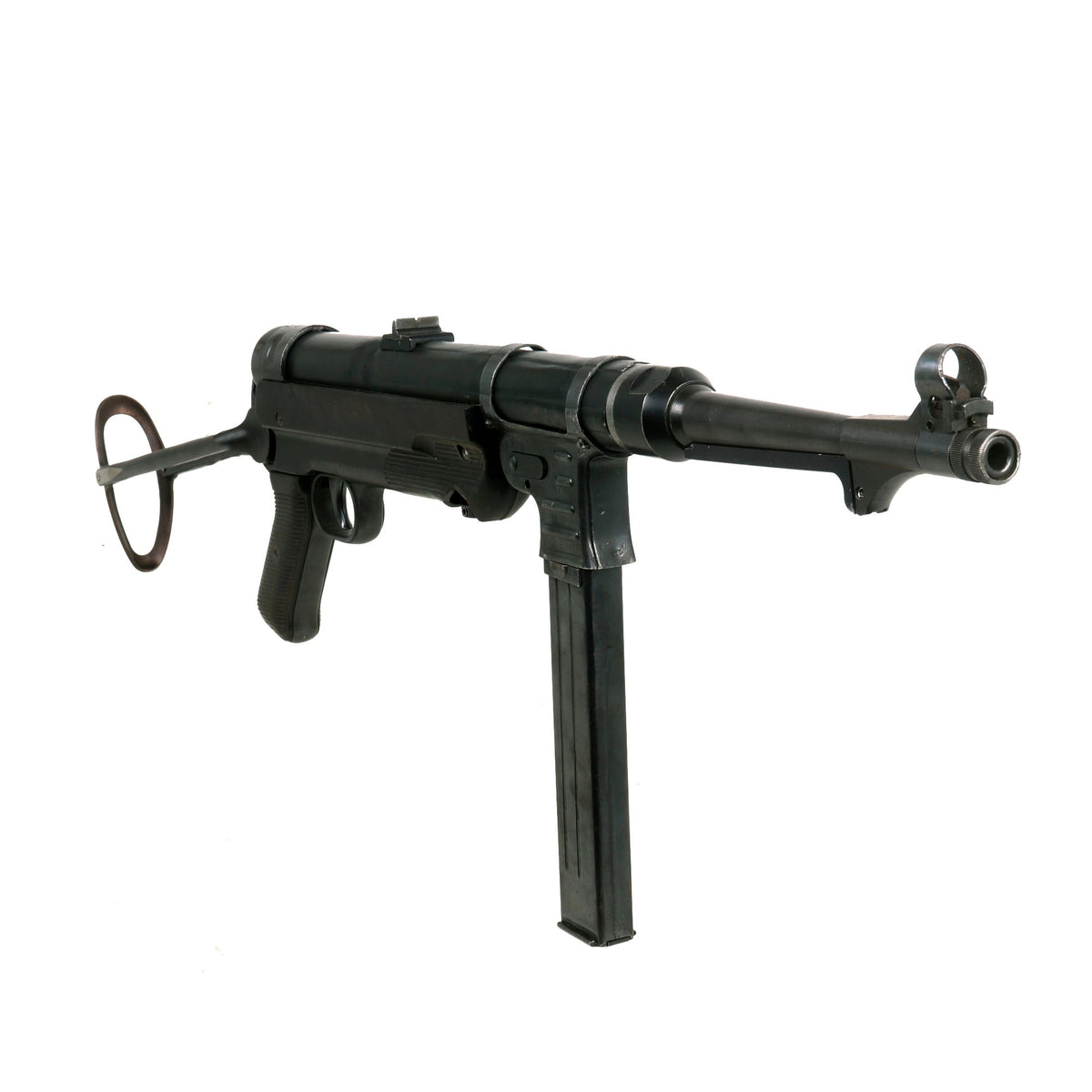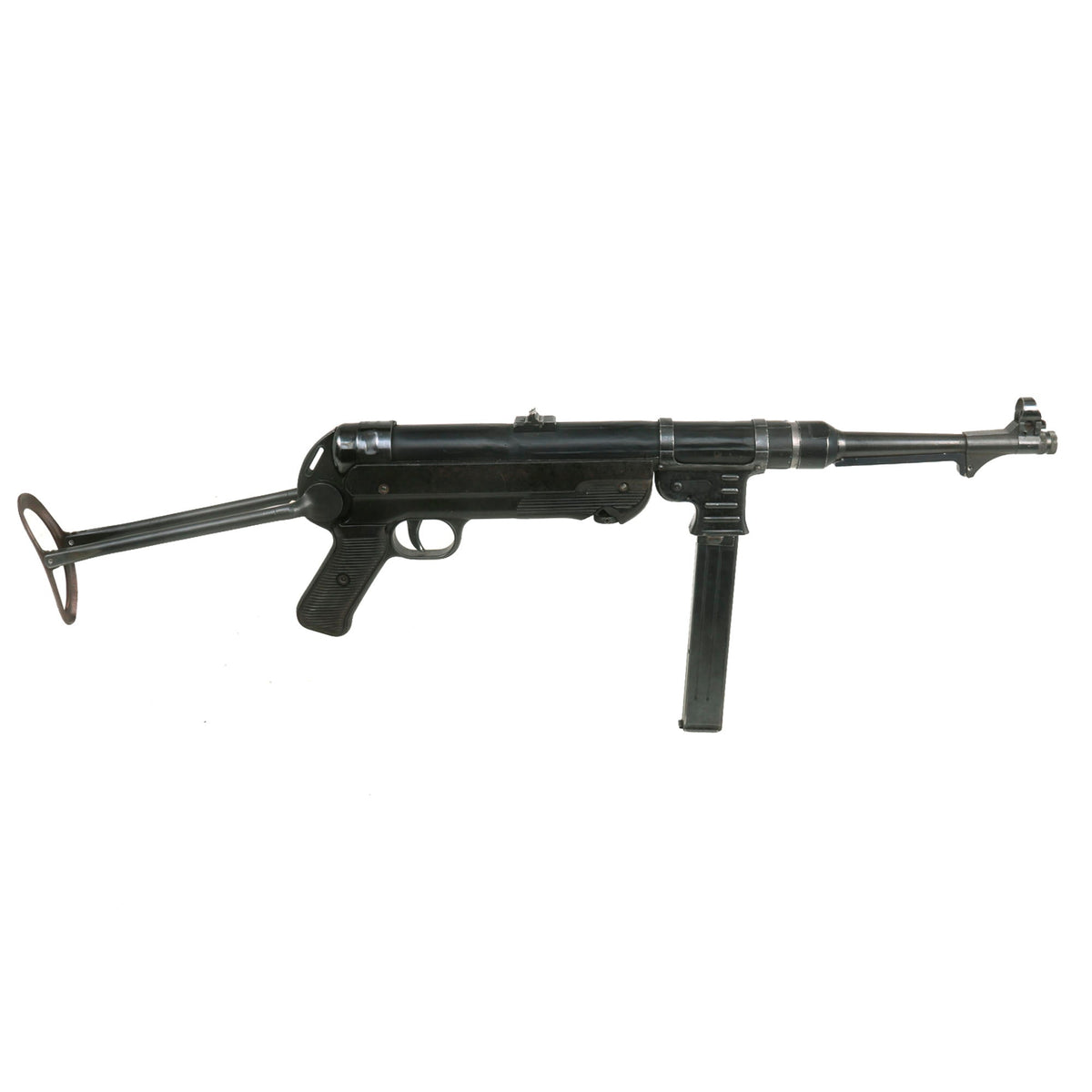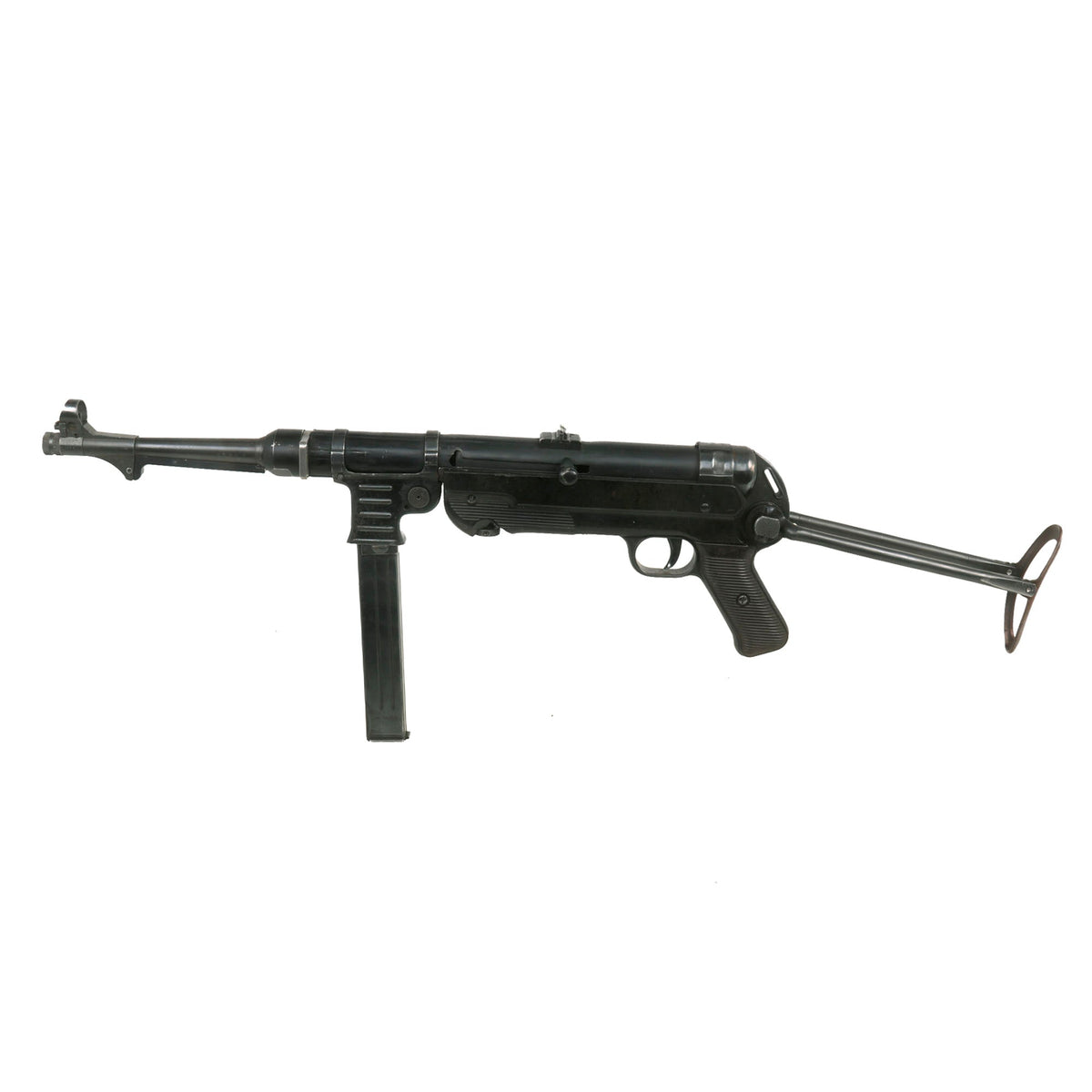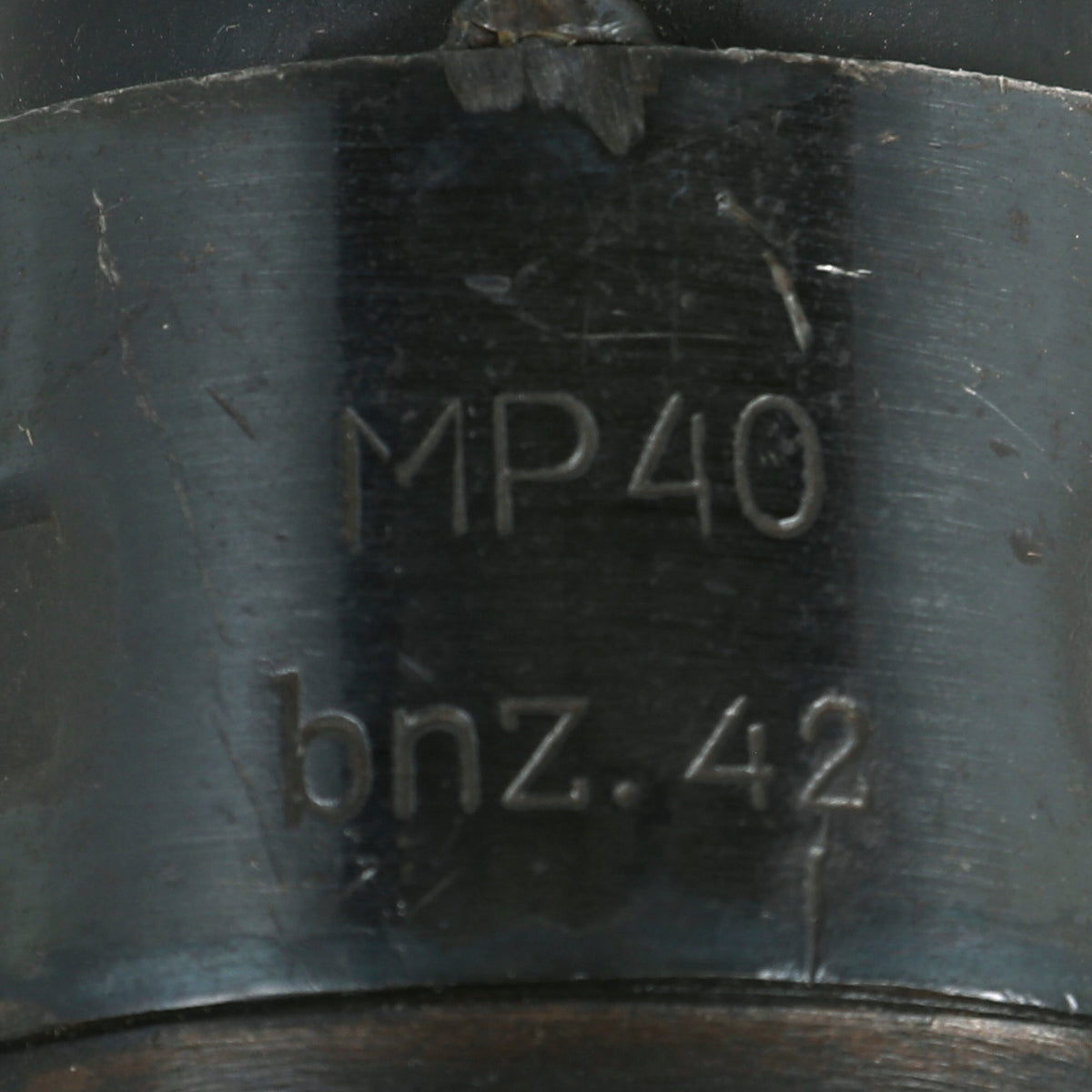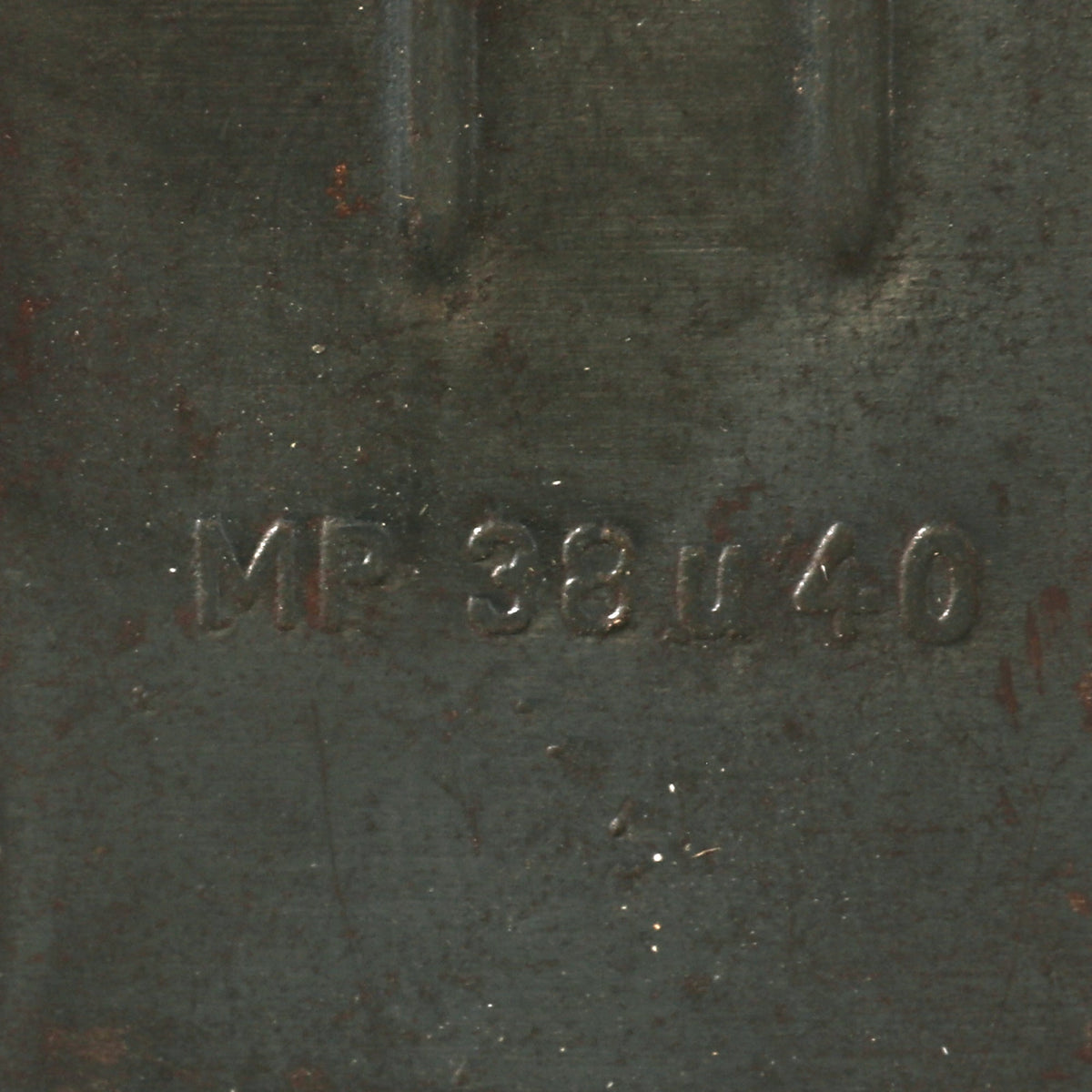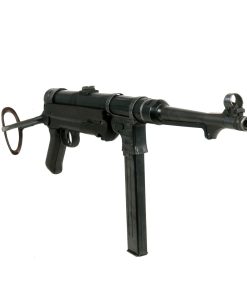Original German WWII 1942 dated MP 40 Display Gun by Steyr with Live Barrel and Magazine – Maschinenpistole 40 Original Items
$ 4.295,00 $ 1.073,75
Original Item: One-of-a-kind. This is an excellent condition MP40 Maschinenpistole 40 display gun, built from an original parts set and constructed on a legal non-firing BATF compliant fabricated steel dummy receiver, making this a 100% legal display Sub-Machine gun. It has properly had 50% of the total length made with solid steel bar stock. Meaning half of the display receiver is solid steel, making this totally legal to own without a license of any kind. Additionally, it has had a deactivated FBP bolt welded inside the receiver to increase the display potential. As the receiver is a complete inert fabricated piece, this display gun is totally legal to own without a license of any kind.
Offered with exceptional original dark brown / black bakelite stock and grips, this is the real thing that will only appreciate in value over time. The extending butt stock is present and fully functional. The barrel is original and has not been deactivated in any way, and the bore is in very good shape, with a bright finish and clear lands and grooves. Original markings have been maintained and make a keystone item for any serious WWII collection.
The rear receiver cup of this display gun is marked with the date and manufacture codes, which are clear:
MP40
bnz. 42
This indicates 1942 manufacture by Steyr-Daimler-Puch AG, Werk Steyr, the legendary Austrian arms company. The serial number on the receiver cup base looks to have been removed at some point, which is fairly common during guns that saw service post war. There is a small bnz marking next to the sling slot on the rear of the pistol grip. There are also other markings and Waffenamt proofs throughout the display gun, as well as mis-matched serial numbers where they are present, so this was probably made from a gun that saw long service, with parts from several guns used to repair it.
The left side of the barrel is marked with serial number 17690, which is most likely remarked, and there is a faint Waffenamt on it, though we cannot read the inspector number. The aluminum resting bar is marked with Waffenamt Eagle / 280, usually associated with ERMA, the designer of the MP40. The sight base is marked with Waffenamt Eagle / 623, associated with Steyr.
Included is an original MP 40 magazine in very good to excellent condition, which is correctly marked MP. 38 u. 40 on the side, with maker code bte 42 on the back for 1942 production by Frank’sche Eisenwerke AG, located in Adolfshütte, Niederscheld / Dillkreis. This ironworking company is a known maker of MP 40 magazines, and it is also marked on the back with partial Waffenamt WaAB37 stamps. Magazine will have the spring and follower removed if shipped to a state that prohibits high capacity magazines.
A great chance to pick up a very great MP40 display gun with a live barrel, complete with an original magazine! We rarely seem them this nice! Ready to display!
History of the MP40
The Maschinenpistole 40 (“Machine pistol 40”) descended from its predecessor the MP 38, which was in turn based on the MP 36, a prototype made of machined steel. The MP 36 was developed independently by Erma Werke’s Berthold Geipel with funding from the German Army. It took design elements from Heinrich Vollmer’s VPM 1930 and EMP. Vollmer then worked on Berthold Geipel’s MP 36 and in 1938 submitted a prototype to answer a request from the Heereswaffenamt (Army Weapons Office) for a new submachine gun, which was adopted as MP 38. The MP 38 was a simplification of the MP 36, and the MP 40 was a further simplification of the MP 38, with certain cost-saving alterations, most notably in the more extensive use of stamped steel rather than machined parts.
It was heavily used by infantrymen (particularly platoon and squad leaders), and by paratroopers, on the Eastern and Western Fronts. Its advanced and modern features made it a favorite among soldiers and popular in countries from various parts of the world after the war. It was often erroneously called “Schmeisser” by the Allies, despite Hugo Schmeisser’s non-involvement in the weapon’s design and production. From 1940 to 1945, an estimated 1.1 million were produced by Erma Werke.
Fast Shipping with Professional Packaging
Thanks to our longstanding association with UPS FedEx DHL, and other major international carriers, we are able to provide a range of shipping options. Our warehouse staff is expertly trained and will wrap your products according to our exact and precise specifications. Prior to shipping, your goods will be thoroughly examined and securely secured. We ship to thousands clients each day across multiple countries. This shows how we're dedicated to be the largest retailer on the internet. Warehouses and distribution centres can be located throughout Europe as well as the USA.
Note: Orders with more than one item will be assigned a processing date depending on the item.
Before shipping before shipping, we'll conduct a thorough inspection of the items you have ordered. Today, the majority of orders will be delivered within 48 hours. The delivery time will be between 3-7 days.
Returns
The stock is dynamic and we cannot completely manage it because multiple stakeholders are involved, including our factory and warehouse. So the actual stock may alter at any time. It's possible that you may not receive your order once the order has been made.
Our policy is valid for a period of 30 days. If you don't receive the product within 30 days, we are not able to issue a refund or an exchange.
You can only return an item if it is unused and in the same state as the day you received it. You must have the item in its original packaging.
Related products
Uncategorized
Uncategorized
Uncategorized
Uncategorized
Uncategorized
Uncategorized
Uncategorized
Uncategorized
Uncategorized
Uncategorized
Armoured Fighting Vehicles of the World: AFVs of World War One (Hardcover Book) New Made Items
Uncategorized
Uncategorized
Uncategorized
Uncategorized
Uncategorized
Uncategorized
Uncategorized
Uncategorized
Uncategorized
Uncategorized
